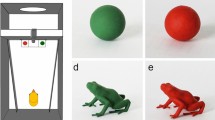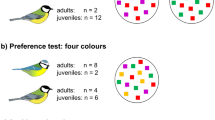Abstract
In birds, the position and extent of the region of binocular vision appears to be determined by feeding ecology. Of prime importance is the degree to which vision is used for the precise control of bill position when pecking or lunging at prey. In birds that do not require such precision (probe and filter-feeders), the bill falls outside the binocular field, which extends above and behind the head, thus providing comprehensive visual coverage. Flamingos Phoenicopteridae are highly specialised filter-feeders. They employ a unique technique that does not require accurate bill positioning in which the inverted head is placed between the feet. Feeding flamingos often walk forwards with the head pointing “backwards”. Here we show that in Lesser Flamingos Phoeniconaias minor visual fields are in fact the same as those of birds that feed by precision pecking and that feeding flamingos are blind in the direction of their walking. We suggest that this is due to the requirement for accurate bill placement when flamingos feed their chicks with “crop-milk”, and possibly when building their nest. We propose that chick-feeding may be the ultimate determinant of visual field topography in birds, not feeding ecology.

Similar content being viewed by others
References
Carboneras C (1992) Family Anatidae (ducks, geese and swans). In: del Hoyo J, Elliot A Sargatal J (eds) Handbook of the birds of the world, vol 1: Ostrich to ducks. Lynx Edicions, Barcelona, pp 536–628
Casini G, Fontanesi G, Bagnoli P (1993) Binocular processing in frontal-eyed birds. In: Zeigler HP Bischof H-J (eds) Vision, brain, and behavior in birds. MIT Press, Cambridge, Massachusetts, pp 159–171
del Hoyo J (1992) Family Phoenicopteriformes (flamingos). In: del Hoyo J, Elliott A Sargatal J (eds) Handbook of the birds of the world, vol. 1: Ostrich to ducks. Lynx Edicions, Barcelona, pp 508–527
Davies MNO, Green PR (1994) Multiple sources of depth information: an ecological approach. In: Davies MNO Green PR (eds) Perception and motor control in birds: an ecological approach. Springer-Verlag, Berlin, pp 339–356
Fernández-Juricic E, Erichsen JT, Kacelnik A (2004) Visual perception and social foraging in birds. TREE 19:25–31
Frost BJ, Wylie DR, Wang YC (1994) The analysis of motion in the visual systems of birds. In: Davies MNO Green PR (eds) Perception and motor control in birds: an ecological approach. Springer-Verlag, Berlin, pp 248–269
Guillemain M, Martin GR, Fritz H (2002) Feeding methods, visual fields and vigilance in dabbling ducks (Anatidae). Funct Ecol 16:522–529
Jäger R, Zeigler HP (1991) Visual field organization and peck localization in the pigeon (Columba livia). Behav Brain Res 45:65–70
Kear J, Duplaix-Hall N (1975) Flamingos. Poyser, Berhampsted
Lee DN (1994) An eye or ear for flying. In: Davies MNO Green PR (eds) Perception and motor control in birds: an ecological approach. Springer-Verlag, Berlin, pp 270–291
Martin GR (1984) The visual fields of the tawny owl, Strix aluco L. Vision Res 24:1739–1751
Martin GR (1986) The eye of a passeriform bird, the European starling (Sturnus vulgaris): eye movement amplitude, visual fields and schematic optics. J Comp Physiol A 159:545–557
Martin GR (1994) Visual fields in woodcocks Scolopax rusticola (Scolopacidae; Charadriiformes). J Comp Physiol A 174:787–793
Martin GR (1999) Eye structure and foraging in King Penguins Aptenodytes patagonicus. J Comp Physiol A 141:444–450
Martin GR, Coetzee HC (2004) Visual fields in Hornbills: precision-grasping and sunshades. J Comp Physiol A 146:18–26
Martin GR, Katzir G (1994) Visual fields and eye movements in herons (Ardeidae). Brain Behav Evol 44:74–85
Martin GR, Katzir G (1995) Visual fields in ostriches. Nature 374:19–20
Martin GR, Katzir G (1999) Visual field in short-toed eagles Circaetus gallicus and the function of binocularity in birds. Brain Behav Evol 53:55–66
Martin GR, Rojas LM, Ramirez Y, McNeil R (2004) The eyes of oilbirds (Steatornis caripensis): pushing at the limits of sensitivity. Naturwissenschaften 91:26–29
Martin GR, Young SR (1983) The retinal binocular field of the pigeon (Columba livia): English racing homer. Vision Res 23:911–915
McFadden SA (1994) Binocular depth perception. In: Davies MNO, Green PR (eds) Perception and motor control in birds: an ecological approach. Springer-Verlag, Berlin, pp 54–73
Piersma T (1996) Family Scolopacidae (sandpipers, snipes and phalaropes). In: del Hoyo J, Elliot A, Sargatal J (eds) Handbook of the birds of the world, vol 3: Hoatzin to auks. Lynx Edicions, Barcelona, pp 444–487
Piersma T van Aelst R, Kurk K, Berkhoudt H, Maas L (1998) A new pressure sensory mechanism for prey detection in birds: the use of principles of seabed dynamics? Proc R Soc Lond B Biol Sci 265:1377–1383
Zeigler HP, Jager R, Palacios AG (1993) Sensorimotor mechanisms and pecking in the pigeon. In: Zeigler HP, Bischof H-J (eds) Vision, brain and behavior in birds. MIT Press, Cambridge, Massachusetts, pp 265–283
Acknowledgements
We thank Terry Hornsey and staff of the Suffolk Wildlife Park, Kessingland, Suffolk, UK, for assistance with this work
Author information
Authors and Affiliations
Corresponding author
Rights and permissions
About this article
Cite this article
Martin, G.R., Jarrett, N., Tovey, P. et al. Visual fields in Flamingos: chick-feeding versus filter-feeding. Naturwissenschaften 92, 351–354 (2005). https://doi.org/10.1007/s00114-005-0010-0
Received:
Accepted:
Published:
Issue Date:
DOI: https://doi.org/10.1007/s00114-005-0010-0




